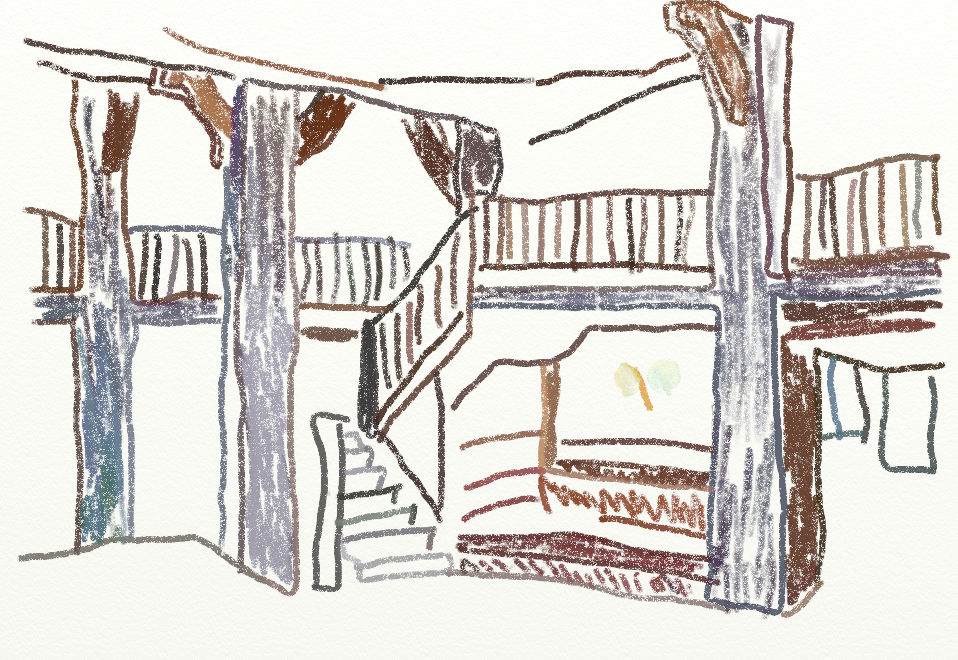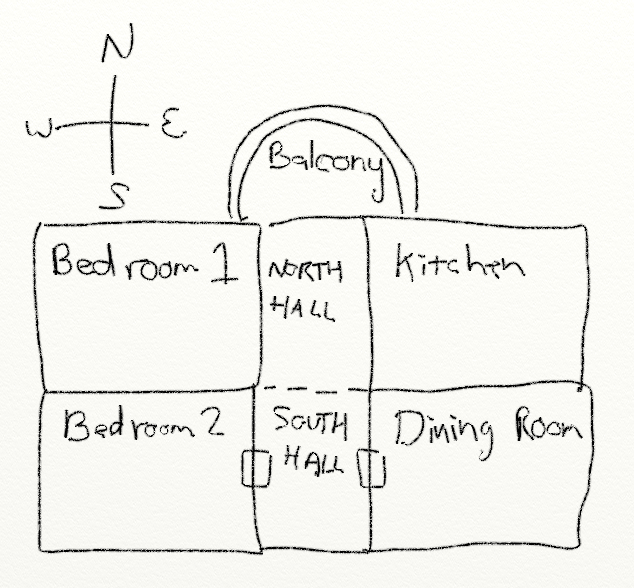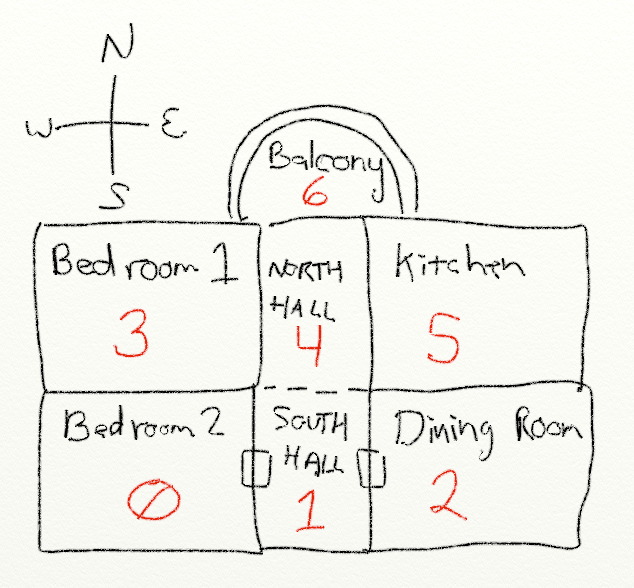Lab 6: Text Adventure

Description of the Adventure Game
One of the first games I ever played was a text adventure called Colossal Cave Adventure. You can play the game on-line here (1), here (2) or here (3) to get an idea what text adventure games are like. Seriously, give it a try. Otherwise it will be hard to understand what we are trying to do here.
Arguably the most famous of this genre of game is the Zork series.
The first “large” program I created myself was a text adventure. It is easy to start an adventure like this. It is also a great way to practice using lists. Our game for this lab will involve a list of rooms that can be navigated by going north, east, south, or west. Each room will be a list with the room description, and then what rooms are in each of the directions. See the section below for a sample run:
Sample Run
You are in a dusty castle room.
Passages lead to the north and south.
What direction? n
You are in the armory.
There is a room off to the south.
What direction? s
You are in a dusty castle room.
Passages lead to the north and south.
What direction? s
You are in a torch-lit hallway.
There are rooms to the east and west.
What direction? e
You are in a bedroom. A window overlooks the castle courtyard.
A hallway is to the west.
What direction? w
You are in a torch-lit hallway.
There are rooms to the east and west.
What direction? w
You are in the kitchen. It looks like a roast is being made for supper.
A hallway is to the east.
What direction? w
Can't go that way.
You are in the kitchen. It looks like a roast is being made for supper.
A hallway is to the east.
What direction?
This game assumes you know the material up through Introduction to Lists and Classes, Constructors, and Attributes.
Creating Your Dungeon
Before you start, sketch out the dungeon that you want to create. It might look something like this:

Next, number all of the rooms starting at zero.

Use this sketch to figure out how all the rooms connect. For example, room 0 connects to room 3 to the north, room 1 to the east, and no room to the south and west.
Step-by-step Instructions
As a reminder, at the end of the year I do scan for duplicate homework. I keep all homework assignments from prior semesters, and assignments from non-Simpson students that I find on-line. I run a program that scans for duplicates. Make sure your work is your own.
Define a class called
Roomas shown in Defining the Class.Define an
__init__(also known as the constructor) method as shown in Defining the Init Function.Define class attributes for
description,north,east,south, andwestas shown in Defining the Init Function. Defaultdescriptionto an empty string, all others to0.Update the
__init__method to take in data for all five attributes when theRoomis created. So instead of defaulting to zero, now set the elements to the parameters passed in. Refer back to Address Class With Init Parameters for an example of what we are looking for.Create a
mainfunction and call themainfunction as shown in Creating a Main Function. Make sure yourmainfunction is not inside theRoomclass.In the
mainfunction, create an empty array calledroom_list. If you’ve forgotten, see Create an Empty List.Create a variable called
room. Set it equal to a new instance of theRoomclass. For the first parameter, create a string with a description of your first room. The last four elements will be the number of the next room if the user goes north, east, south, or west. Look at your sketch to see what numbers to use. UseNoneif no room hooks up in that direction. (Do not putNonein quotes. Also, remember that Python is case sensitive sononewon’t work either. The keywordNoneis a special value that represents “nothing.” Because sometimes you need a value, other than zero, that represents )Append this room to the room list. See Adding to a List if you’ve forgotten how to do that.
Repeat the prior two steps for each room you want to create. Just re-use the
roomvariable.Create a variable called
current_room. Set it to zero.Print the
room_listvariable. Run the program. You should see a really long list of every room object in your adventure that looks something like this strange line:[<__main__.Room object at 0x03800520>, <__main__.Room object at 0x0398F220>,
If you don’t, make sure you are calling your
mainfunction at the end of your program, and that it isn’t indented.Adjust your
print statementto only print the first room (element zero) in the list. Run the program and confirm you get output similar to:<__main__.Room object at 0x03800520>
Using
current_roomandroom_list, print the current room the user is in. Since your first room is zero, the output should be the same as before.Change the print statement so that you only print the description of the room, and not the strange object printing we are getting now. You can do that by appending
.descriptionto what you printed in the prior step. When you run it, you should get your room description:You are in a room. There is a passage to the north.
Create a variable called
doneand set it toFalse. Then put the printing of the room description in awhileloop that repeats untildoneis set toTrue. We won’t setdonetoTrueyet though.Before printing the description, add a code to print a blank line. This will make it visually separate each turn when playing the game.
After printing the room description, add a line of code that asks the user what they want to do. Use the
inputstatement. Keep in mind that you will be entering letters, therefore you will not want to convert what the user enters to an integer or floating point number. This will be similar to how we got input in Lab 4: Camel. The most frequent mistake I’ve seen students make is to have aninputstatement and not capture the return value. See Capturing Returned Values if you have this issue.Add an
ifstatement to see if the user wants to go north. You should accept user input like “n” and “N” and “North” and “NoRtH”. You may need to review Text Comparisons and Multiple Text Possibilities.If the user wants to go north, create a variable called
next_roomand get it equal toroom_list[current_room].north, which should be the number for what room is to the north.Add another
ifstatement to see if the next room is equal toNone. If it is, print “You can’t go that way.” Otherwise setcurrent_roomequal tonext_room. Note: This newifstatement is part of theifstatement to go north. So make sure it is indented inside thatif. Also, if you are doing one choice or another, remember to useelse.Test your program. Can you go north to a new room?
Add
elifstatements to handle east, south, and west. Add anelsestatement to let the user know the program doesn’t understand what she typed.It is a great idea to put blank lines between the code that handles each direction. I don’t mean to print a blank line, but actually have blank lines in the code. That way you visually group the code into sections.
It is a great idea to add comments too, to each section.
Test your program. Make sure you have enough of a description that someone running the program will know what direction to go. Don’t say “You are in the kitchen.” Instead say “You are in the kitchen. There is a door to the north.”
Add a quit command that ends the game.
Spend a little time to make this game interesting. Don’t simply create an “East room” and a “West room.” That’s boring.
Also spend a little time to double check spelling and grammar. Without a word processor checking your writing, it is important to be careful. Pay particular note to:
In the past I’ve had people capitalize words in this lab that should not be capitalized. Incorrect capitalization of directions are common. See when do you capitalize directions.
Do not capitalize room names unless the room name is part of a title. Don’t say “You are in the Living Room,” because the word “living room” isn’t normally capitalized.
Use \n to add carriage returns in your descriptions so they don’t print all on
one line. Don’t put spaces around the \n, or the spaces will print.
What I like about this program is how easy it is to expand into a full game. Expanding the game to use all eight cardinal directions (including “NorthWest”), along with “up” and “down” is rather easy. Managing an inventory of objects that can exist in rooms, be picked up, and dropped is just a matter of keeping lists.
Expanding this program into a full game is one of the two options for the final lab in this course.